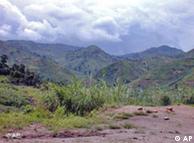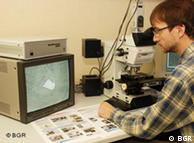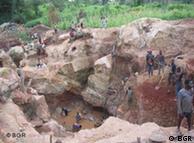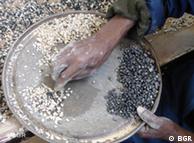In the late 1990s
and early 2000s the world began to wake up to the reality of "blood
diamonds," or diamonds mined in regions of sub-Saharan Africa used to
fund violent conflicts, especially in Liberia, Angola and Sierra Leone.
But over the last
decade, activists, scientists, and politicians have also been made
increasingly aware of the use of coltan mining to fund similar conflicts
central Africa, especially in the Democratic Republic of Congo (DRC).
In 2009, German
mineral authorities said that Africa produced half of the world's
coltan, significantly up from previous years as major mines in Canada
and Australia were shut down due to coltan's falling price. The metallic
ore contains tantalum, a key element in the production of
semi-conductors and capacitors found in nearly every consumer electronic
device, including iPods, mobile phones and video game consoles.
A study released in
May by the London-based Resource Consulting Services (RCS) said that in
2009, a group of Hutu rebels in Rwanda, the Democratic Forces for the
Liberation of Rwanda, were 75 percent funded by the sale of minerals
like coltan.
 Bildunterschrift: Großansicht des Bildes mit der Bildunterschrift: The Masisi region in eastern Congo contain important deposit of coltan
Bildunterschrift: Großansicht des Bildes mit der Bildunterschrift: The Masisi region in eastern Congo contain important deposit of coltan
But governments
worldwide are starting to take action. US President Barack Obama
recently signed into law a provision requiring more transparency in the
mineral mining sector. The European Union does not currently have any
similar provisions.
The American law will
require companies sourcing coltan from the DRC and its nine neighboring
countries, including Rwanda, to prove that their mineral exports are
conflict-free. Some development activists have said that while this is a
positive development, turning the new law into an effective embargo may
be a nearly impossible task.
But in recent years,
German scientists have said that they have found a method of chemical
analysis to determine which coltan samples are conflict-free. They said
each coltan sample from a particular mine has a given "fingerprint," or
unique set of characteristics.
'It's a totally different mineralogy'
From his office at the
Federal Institute for Geosciences and Natural Resources in Hannover,
Frank Melcher has a collection of rock cuttings in small see-through
boxes and plastic bags spread out. Next to each box and bag he puts a
color print-out of pictures taken with an electron microscope. To the
untrained eye they look like pictures of mosaic floor, but for Melcher
they indicate far more.
"If you compare coltan
samples from different proveniences, it's quite obvious," he said.
"This is a sample from Rwanda, this one's from Australia. The dye
distribution is totally different. It's a totally different mineralogy."
 Bildunterschrift: Großansicht des Bildes mit der Bildunterschrift: Melcher examines the origin of coltan
Bildunterschrift: Großansicht des Bildes mit der Bildunterschrift: Melcher examines the origin of coltan
Melcher is one of many
German scientists working to set up a "certified trading chain," which
would establish the origin of coltan samples.
He relies on more than
using visual cues to identify a coltan sample's provenance. Melcher and
his colleagues also use an electron microprobe that hits the sample
with an electron beam. The emerging x-rays indicate which chemical
elements are contained in the sample.
"I can see right away
what elements are contained in this sample and how much of them," he
said. "Here it's tantalum, there it's niobium, manganese, iron and I
spot some titanium as well."
German government
scientists are using this technique to register the fingerprints of
legitimate mines that then could be compared to field samples mined in
the future. The idea would be to provide incontrovertible evidence
showing that a sample of coltan was mined in a conflict-free zone.
Melcher said he has reference samples from 75 percent of the world's
coltan mines.
"We hope that one day only truly clean products leave African soil," he said.
"In connection with
environmental and social standards this could be the way to go for raw
materials," he added. "We want a trading chain with European and
American companies purchasing goods directly from the African market.
This is impossible for them at the moment."
However, samples from mines in China and the DRC comprise the remaining 25 percent, he added.
"The Chinese aren't interested in delivering samples, and DRC is impossible to access," he said.
European refineries stand to benefit
 Bildunterschrift: Großansicht des Bildes mit der Bildunterschrift: The German process could limit coltan mining to conflict-free regions
Bildunterschrift: Großansicht des Bildes mit der Bildunterschrift: The German process could limit coltan mining to conflict-free regions
Some German companies
have already been affected by the shadiness of the coltan trade. H.C.
Starck, based in the central German city of Goslar, has one of the many
refineries around Europe that takes coltan ore and refines it into pure
tantalum.
H.C. Starck is one of
the few companies capable of completing the complex process of making
tiny, reliable and heat-resistant capacitors out of tantalum. But 10
years ago the United Nations accused the company of using tantalum from
war-torn regions of Congo and H.C. Starck's reputation suffered
significantly.
After the accusations
became public, the company began cooperating with the United Nations and
re-evaluated its coltan acquisition process. Starck now does not
purchase any tantalum from Africa.
"While working through
everything together with the UN panel, we found out, that not every
retailer had told us the truth concerning the material's origin -
despite assuring otherwise," said Manfred Buetefisch, a company
spokesperson. "That's when we realized that - seeing the ongoing war in
East Africa and the DRC - that they are not reliable partners for us,
and that we cannot buy any material there anymore."
Companies like H.C.
Stark are now banking on being able to rely more and more on African
coltan. The company already bought a NRD Rwanda, a small mining company
in Rwanda. Soon, every one of its deliveries will be certified by the
Federal Institute for Geosciences and Natural Resources in Hannover.
Rock cuttings for the
license have already been already charted and included in Frank
Melcher's database. By taking random control samples the geologist can
now verify whether coltan was taken from the company's mine in Rwanda.
"This is of course an
ideal case: a company investing in the local mining industry, importing
the coltan on its own and making sure that it is no illegally mined
material infecting the trading chain," Melcher said.
Certification is slow moving
 Bildunterschrift: Großansicht des Bildes mit der Bildunterschrift: Coltan is often separated from other rocks by hand
Bildunterschrift: Großansicht des Bildes mit der Bildunterschrift: Coltan is often separated from other rocks by hand
One year ago the
Federal Institute for Geosciences and Natural Resources invited all 10
Rwandan mining companies for a certification workshop. The companies'
chief executives were reserved in the beginning but four companies
joined NRD Rwanda and have signed up for the testing procedures.
Industry analysts have
said that the new practice may pressure African coltan-exporting
countries to clean up their mining practices on their own, without
relying on harsher external policies.
"This might limit
corruption, violence and other conflicts fought over coltan and other
resources," said Peter Eigen of the NGO Transparency International.
"Once the companies voluntarily agree to cooperate, it's easier to make a
point rather than trying to boycott these raw materials or subject them
to certain conditions."
But first, the
Hannover geologists have to adapt their methods to the industry in the
Congo. And they all know that it's a far cry from the way things work in
Rwanda to the unstable situation in the Democratic Republic of the
Congo.
While German
scientists say getting Congo and China to adopt their methods will be
difficult, they said they are confident their process change coltan
mining in the long term. While they are willing to provide the
fingerprinting system, they say that the certification chain must be
located in Africa to be most effective, and that its implementation
remains a local political issue.
"There will be a big
meeting in Nairobi before the end of the year for certification
procedures," Melcher said. "We hope that fingerprinting will be part of
the measures that they take."
Author: Jan Lublinski / Monika Griebeler / Cyrus Farivar
Editor: Sean Sinico
http://www.dw-world.de/dw/article/0,,5907446,00.html












